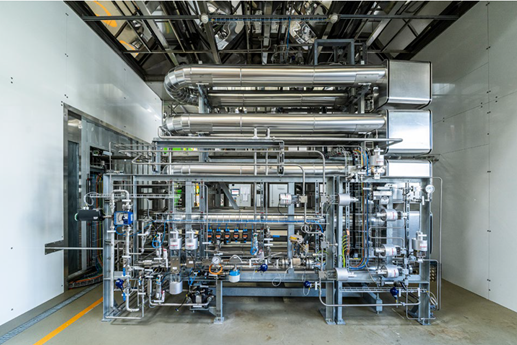HydroPilot: A pilot plant for hydrothermal gasification of wet biomass
HydroPilot is a pilot plant for hydrothermal gasification of wet biomass located at the Paul Scherrer Institute (PSI). Recently, the first successful test with sewage sludge has been conducted, proving that sewage sludge can be gasified at pilot scale. IBRE collaborated in the build-up of the plant, in modeling the heat exchanger, and in conducting experimental campaigns.
Hydrothermal gasification (HTG) is a process that allows converting wet biomass into a methane-rich product gas without the need of previously drying the feed. Materials with dry matter contents of up to 20% are suitable for HTG. The limiting factor is the ability to pump the slurry. Promising materials for HTG are for example sewage sludge or algae. Their high water content makes them ideal candidates for HTG, as burning these materials would require an energy intensive drying step.
HTG works at high temperature (450°C) and pressure (280 bar). At those conditions, water is in the supercritical state, which has two main benefits. The first advantage is that organic components are well miscible with supercritical water, allowing for fast conversion. Secondly, the solubility of salts is significantly lower than in liquid water. This behavior allows salts to be separated from the main process stream and the nutrients to be recovered. One such nutrient is phosphorus, which can then be reused as a fertilizer.
After the technology was proven on a laboratory scale, HydroPilot was built to verify the scalability of the process. The throughput was increased from 1 kg/h of sewage sludge on the laboratory scale to 100 kg/h on the pilot scale. Apart from answering the question regarding the applicability on an industrial level, the pilot plant will also produce substantial amounts of salt brine. These large quantities of brine are necessary for scaling up and improving the recovery of nutrients.
Recently a first successful campaign has been conducted, proving that sewage sludge can be gasified in HydroPilot. The next steps will be to gradually increase the dry matter content of sewage sludge and improve the salt separating efficiency on HydroPilot.
The project is funded within the Pilot and Demonstration program of the Swiss Federal Office of Energy and is a collaboration between PSI and the industry partners TreaTech, KASAG Swiss AG, ExerGo, and Afry Schweiz AG. FHNW-IBRE is a subcontractor to PSI.

